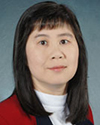Distinguished Lecturers
To request a Distinguished Lecturer (DL) for your next event, complete the DL Application Form. For more information or to see the full list, go to the Distinguished Lecturers page.

Tel Aviv, Israel
Dan Halperin received his Ph.D. in Computer Science from Tel Aviv University. He then spent three years at the Computer Science Robotics Laboratory at Stanford University. In 1996 he joined the Department of Computer Science at Tel Aviv University, where he is currently a full professor and for two years was the department chair. Halperin's main field of research is Computational Geometry and Its Applications. Much of his work concerns "geometric arrangements", which are fundamental constructs underlying the algorithmic solution of geometric problems in a wide variety of domains. Application areas he is currently interested in include robotics, automated manufacturing, algorithmic motion planning, and 3D printing. In 2015 he was named an IEEE Fellow. Halperin was the program-committee chair/co-chair of several conferences in computational geometry, algorithms and robotics, including SoCG, ESA, ALENEX, and WAFR. He is on the editorial board of a couple of journals in computational geometry and robotics. A major focus of Halperin's work is in research and development of robust geometric software, in collaboration with a group of European universities and research institutes: the CGAL project and library.
Talk # 1
Multi-Robot Motion Planning: The Easy, the Hard and the Uncharted
Early results in robot motion planning had forecast a bleak future for the field by showing that problems with many degrees of freedom, and in particular those involving fleets of robots, are in tractable. Then came sampling-based planners, which have been successfully, and often easily, solving a large variety of problems with many degrees of freedom. We strive to formally determine what makes a motion-planning problem with many degrees of freedom easy or hard. In the first part of the talk I'll describe our quest to resolve this (still wide open) problem, and some progress we have made in the context of multi-robot motion planning. In the second part of the talk I'll review recent algorithms that we have developed for multi-robot motion planning, which come with near- or asymptotic-optimality guarantees.
Talk # 2
From Piano Movers to Piano Printers: Computing and Using Minkowski Sums
The Minkowski sum of two sets P and Q in Euclidean space is the result of adding every point (position vector) in P to every point in Q. Minkowski sums constitute a fundamental tool in geometric computing, used in a large variety of domains including motion planning, solid modeling, assembly planning, 3d printing and many more. At the same time they are an inexhaustible source of intriguing mathematical and computational problems. We survey results on the structure, complexity, algorithms, and implementation of Minkowski sums in two and three dimensions. We also describe how Minkowski sums are used to solve problems in an array of applications, and primarily in robotics and automation.

Queenstown, Singapore
David Hsu received BSc in computer science & mathematics from the University of British Columbia, Canada and PhD in computer science from Stanford University, USA. He is currently a professor of computer science at the National University of Singapore (NUS) and the Deputy Director ofNUS Advanced Robotics Center. He is an IEEE Fellow. His recent research focuses on robot planning and learning under uncertainty and human-robot collaboration. He, together with colleagues and students, won the Humanitarian Robotics and Automation Technology Challenge Award at International Conference on Robotics & Automation (ICRA) 2015, the RoboCup Best Paper Award at International Conference on Intelligent Robots & Systems (IROS) 2015, and the Best Systems Paper Award at Robotics: Science & Systems (RSS), 2017. He has chaired or co-chaired several major international robotics conferences, including ICRA 2016, RSS 2015, and International Workshop on the Algorithmic Foundation of Robotics (WAFR) 2004 and 2010. He was an associate editor of IEEE Transactions on Robotics. He is currently an editorial board member of Journal of Artificial Intelligence Research and a member of the RSS Foundation Board.
Talk # 1
Robot Decision-Making under Uncertainty: From Data to Actions
Planning and learning are two primary approaches to intelligent robots. Planning enables us to reason about the consequences of immediate actions far into the future, but it requires accurate world models, which are often difficult to acquire in practice. Policy learning circumvents the need for models and learns a mapping from robot perceptual inputs to actions directly. However, without models, it is much more difficult to generalize and adapt learned policies to new contexts. In this talk, I will present our recent work on robust robot decision-making under uncertainty through planning, through learning, most importantly by integrating planning and learning. I will give several examples, including autonomous vehicle navigation among many pedestrians and human-robot interactive tasks.
Talk # 2
Towards Seamless Human-Robot Collaboration: Intention, Trust, and Adaptation
Early robots often occupied tightly controlled environments, e.g., factory floors, designed to segregate robots and humans for safety. In the near future, robots will "live" with humans, providing a variety of services at homes, in workplaces, or on the road. To become effective and trustworthy collaborators, robots must adapt to human behaviors and more interestingly, adapt to changing human behaviors, as humans adapt as well. I will discuss our recent work on (i) mathematical models for human intentions and trust and (ii) planning and learning algorithms that leverage the model to enable effective robot adaptation to humans. This discussion, I hope, will spur greater interest towards principled approaches that integrate perception, planning, and learning for seamless human-robot collaboration.
Primary Keywords: Manipulation Planning; Mobile Manipulation; Social Human-Robot Interaction; Autonomous Vehicle Navigation; Visual-Based Navigation; Deep Learning in Robotics and Automation; Task Planning; Motion and Path Planning; Nonholonomic Motion Planning; Path Planning for Multiple Mobile Robots or Agents; Reactive and Sensor-Based Planning; Collision Avoidance
Secondary Keywords: Formal Methods in Robotics and Automation; Grasping; Human-Centered Robotics; Learning from Demonstration; Surgical Robotics: Planning; Service Robots
T-RO Editor: July 1, 2023 – June 30, 2028

Chapel Hill (NC), USA
Ming C. Lin is currently the Elizabeth Stevinson Iribe Chair of Computer Science at the University of Maryland College Park and John R. & Louise S. Parker Distinguished Professor Emerita of Computer Science at the University of North Carolina (UNC), Chapel Hill. She is also an honorary Chair Professor (Yangtze Scholar) at Tsinghua University in China. She obtained her B.S., M.S., and Ph.D. in Electrical Engineering and Computer Science from the University of California, Berkeley. She received several honors and awards, including the NSF Young Faculty Career Award in 1995, Honda Research Initiation Award in 1997, UNC/IBM Junior Faculty Development Award in 1999, UNC Hettleman Award for Scholarly Achievements in 2003, Beverly W. Long Distinguished Professorship 2007-2010, Carolina Women’s Center Faculty Scholar in 2008, UNC WOWS Scholar 2009-2011, IEEE VGTC Virtual Reality Technical Achievement Award in 2010, and many best paper awards at international conferences. She is a Fellow of ACM, IEEE, and Eurographics.
Talk # 1
From Learning-based Traffic Reconstruction to Autonomous Driving
Rapid urbanization and increasing traffic have led to digitalization of modern cities and automation of transportation means. As new technologies like autonomous systems and self-driving robots emerge, there is an increasing demand to incorporate realistic traffic flows into design of autonomous vehicles. In this talk, we first present a novel method for statistically-based inferencing and traffic visualization using GPS data. This approach reconstruct city-scale traffic using statistical learning on GPS data and metamodel-based simulation optimization for dynamic data completion in areas of insufficient data coverage. Next, we present a unified collision avoidance algorithm for the navigation of arbitrary intelligent agents, from pedestrians to various types of robots, including vehicles. This approach significantly extends our statistically-based WarpDriver algorithm specialized for disc-like agents (e.g. crowds) to a wide array of robots (e.g. autonomous vehicles of different shapes) in a unifying framework using different nonlinear motion extrapolations to support agent dynamics, with additional shapes and soft constraints, to simulate vehicle traffic. Finally, we introduce a learning-based, multi-level control policy for autonomous vehicles by analyzing simulated accident data and using our collision avoidance algorithm, automatic data annotation, and parameterized traffic & vehicle simulation. We conclude by suggesting possible future directions.
Talk # 2
Data-Driven Modeling of Non-Rigid Bodies for Robotics
Non-rigid materials are widely used in medical robotics, design and manufacturing, virtual surgery for soft robot planning, procedural rehearsal and training, etc. Identification of mechanical properties, such as tissue elasticity parameters, is critical to enable medical robots to safely operate within highly unstructured, deformable human bodies and to compute desired, accurate force feedback for individualized haptic display characterized by patient-specific parameters. In addition to medical robots, simulations are also increasingly used for rapid prototyping of clinical devices, pre-operation planning of medical procedures, virtual training exercises for surgeons and supporting personnel, etc. And, bio-tissue elasticity properties are central to developing realistic and predictive simulation and for designing responsive, dexterous surgical manipulators. Furthermore, with increasing interest in 3D printing for rapid creation of soft robots consisting of flexible materials, the ability to easily acquire material properties from existing sensor data, such as medical images and videos, can help to replicate similar material properties. In this talk, I present recent advances to determine patient-specific tissue elastic parameters from images and videos, acceleration techniques, and application to medical applications. I conclude by discussing possible future directions and new challenges.